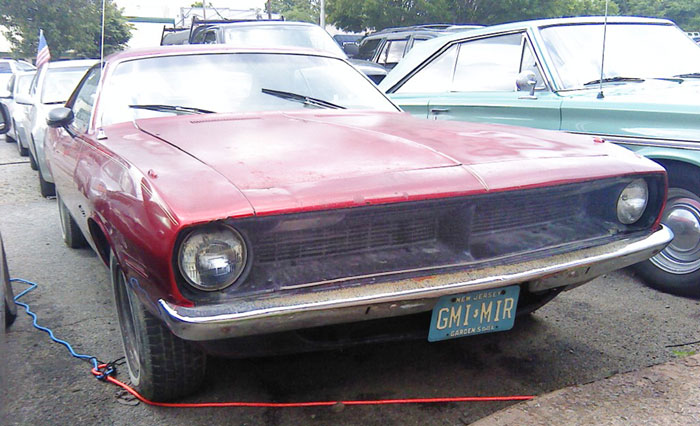
This time I bring you a Double Feature: a 1970 Plymouth Barracuda and a 1966 Plymouth Belvedere II.
I saw these cars side-by-side at a Denville, New Jersey repair shop in June 2012. First, the Barracuda: I believe this is a ’70 model because of the grille design and the turn signals being just below the hood. The side-marker lights also look like a 1970 style.
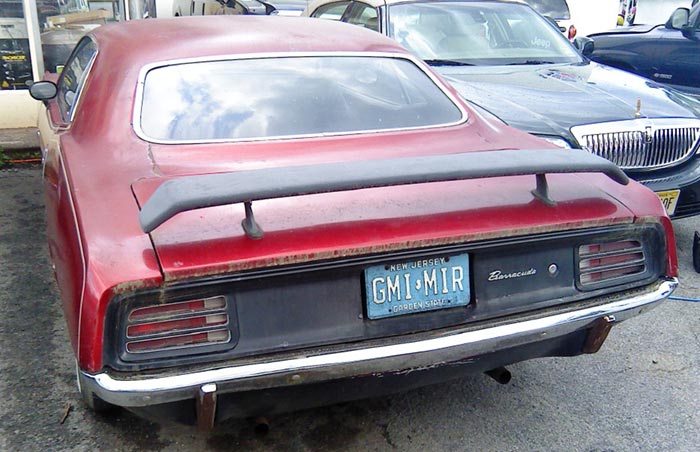
While it wasn’t a ’Cuda and has a flat hood, the Barracuda had dual mirrors, dual exhaust, and minimal rust, but it was just a little rough around the edges. The paint appeared to be Deep Burnt Orange Metallic, a factory color. It had bucket seats and a black interior, with, I imagine, a 318 cubic inch V-8. I’m sure the rear spoiler was added at some point; perhaps someone was shooting for a ’Cuda clone or mild custom as the years went by.
Now, the Belvedere: I think this is a ’66 Belvedere II because of the wide chrome spears that run the length of the car and the satin finished lower trunk lid panel. The paint is light green; I found a close match of “Turf Green” on a 1966 Sherwin-Williams chip chart for Dodge trucks, but couldn’t find this color on ’66 Plymouth charts.
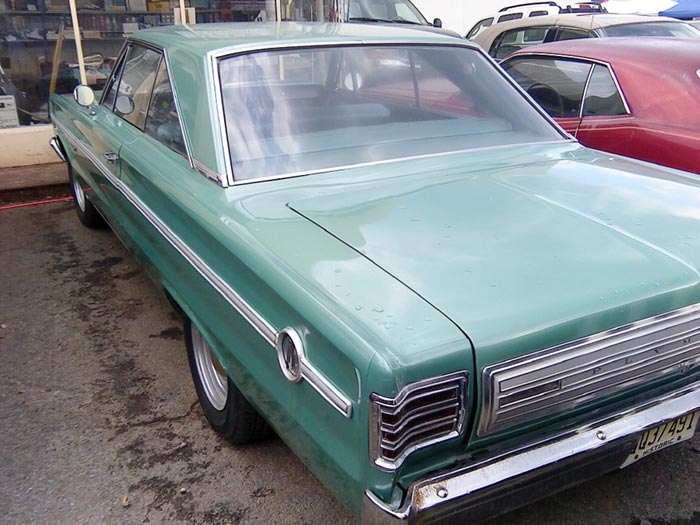
I think the fender badges indicate a V-8, likely a 273. 1966 was the first year for the 426 Street Hemi (made famous in racing form by Richard Petty), but what are the chances that this is a first year Hemi car?
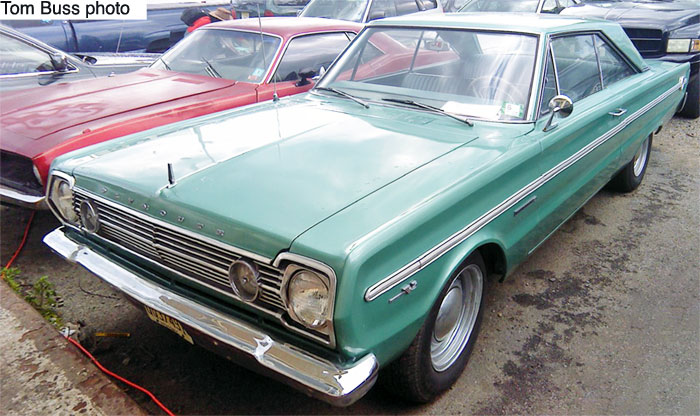
It had a bench seat and light green interior. The paint, chrome and glass were in great condition with virtually no rust. Given their appearance, I’d pick the Belvedere over the Barracuda; but since they’ve survived 53 and 57 years respectively, I’m just glad to have spotted them in public, in any condition. They weren’t for sale and I haven’t seen them for at least ten years, but I always enjoy the lucky break of spotting an old Mopar.
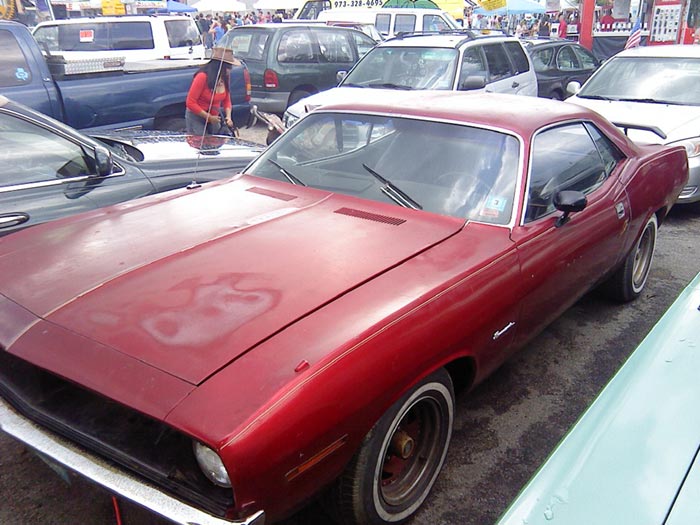
Plymouth made a boatload of 1966 Belvederes—48,644 of the low-trim Belvedere I and 102,450 of the high-trim Belvedere II in the US alone, as well as more in Canada. There were also 38,158 Belvedere Satellites, to become their own model in 1968; together, that was 189,252 Belvederes. The Fury, one more model up, was even more popular. The entry level 1966 Valiant, then on its original sporty body, saw 176,166 sales, including 38,029 Barracudas.
With muscle cars rapidly gaining in sales, Burt Bouwkamp successfully pushed Chrysler’s top execs to approve a new model which was smaller than the B-body Belvedere, but could easily pack any engine the company had. This new “E-body,” sold as the 1970 Dodge Challenger and Plymouth Barracuda, was supposed to have a “conservative” 100,000 sales. The 1970 Barracuda—the model shown here—saw production of just 27,205 in its first year. It was unable to get the kind of reviews it needed; and it was overshadowed by the one-two punch of the Road Runner, launched in 1968, and the new 1970 Plymouth Duster.
The Belvedere was still around but it had even fewer sales than the Barraucda. The company made just 24,246 Belvederes in the US in 1970; essentially the same car was sold as the Road Runner, GTX, and Satellite, but even combining all of these didn’t match the 1966 Belvedere’s success. Note: All production figures are for the calendar year, not the model year.
STLA jumps into robotaxis with Uber, Nvidia, Foxconn
Ford, Tesla, Stellantis dominate recalls this week
Toledo Jeep plant on “emergency status”
More fish stories of Mopar cars and trucks
Big Chrysler, Spooky Imperial: Car Spotter #29
Driving a three-on-the-tree 1977-ish Dodge pickup
1970-71 Dodge W300 Power Wagon
Vintage Dodge Bros, Plymouth, and Dinky models
1975 Dodge Charger SE: Comfy but slow cruiser
1957 Plymouth Belvedere Convertible
1940s Dodge pickup: Car Spotter #20
1949 DeSoto Custom: Car Spotter #19
1967 Dodge Coronet 440: Car Spotter #18
Car Spotter #17: 1966 Chrysler 300
Car Spotter: 1950 Plymouth
Car Spotter: Imperial Crown and Valiant
Car Spotter: Dodge D-200 Power Wagon
Car Spotter: Custom Ram Van Minivan
Car Spotter: Mopars of the Hagley Car Show
Car Spotter: C-100 California Pickup
Car Spotter: 1948 Chrysler Windsor and 1940 Dodge at a Newark used car lot
Car Spotter Plymouth Twofer: Belvedere and Horizon
Car Spotter: circa-1970 Dodge C-series medium duty truck
Van Spotter: Daily-driver Dodge B-van
Car spotter: Dodge D-200
Car Spotter: Plum Crazy 1971 Dodge Challenger
Car Spotter: 1971 Plymouth Fury Pursuit Car
Car Spotter: 1914 Dodge Bros. Touring Car
1951 DeSoto: Toothy-Grilled Car Spotter
Copyright © 2021-2025 Zatz LLC • Chrysler / Mopar car stories and history.
YouTube • Editorial Guidelines • Videos